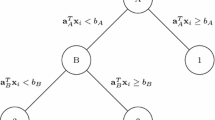Abstract
Given a pair of finite disjoint setsA andB inR n, a fundamental problem with many important applications isto efficiently determine a hyperplaneH(w,λ) which separates these sets when they are separable, or ‘nearly’ separates themwhen they are not. We seek a hyperplane which minimizes a natural errormeasure in the latter case, and so will ‘surgically’ separate the sets. Whenthe sets are separable in a strong sense, we show that the problem is aconvex program with a unique solution, which has been investigated byothers. Using the KKT conditions, we improve on an existing algorithm. Whenthe sets are not separable, the problem is nonconvex, generally with properlocal solutions, and we solve an equivalent problem by Branch and Bound.Numerical results are presented.
Similar content being viewed by others
References
K.P. Bennett and O.L. Mangasarian, Robust linear programming discrimination of two linearly inseparable sets. Optimization Methods and Software 19(2) (1992), 23–24.
J.E. Blankenship and J.E. Falk, Infinitely constrained optimization problems. Journal of Optimization Theory and Applications 19(1976), 261–281.
T.M. Cavalier, J.P. Ignizio, and A.L. Soyster, Discriminant analysis via mathematical programming: Certain problems and their causes. Computers and Operations Research 16(4), (1989), 353–362.
J.E. Falk and R.M. Soland. An algorithm for separable nonconvex programming problems. Management Science 15(1969), 550–569.
N. Freed and F. Glover, A linear programming approach to the discriminant problem. Decisions Sciences 12(1981), 68–74.
N. Freed and F. Glover, Evaluating alternative linear programming models to solve the two-group discriminant problem. Decisions Sciences 17(1986a), 151–162.
N. Freed and F. Glover, Resolving certain difficulties and improving the classification power of lp discriminant analysis formulations. Decisions Sciences 17(1986b), 589–595.
L.W. Glorfeld and N. Gaither, On using linear programming in discriminant problems. Decision Sciences 13(1982), 167–182.
F. Glover, Improved linear programming for discriminant analysis. Decision Sciences 21(1990), 771–785.
F. Glover, S. Keene, and B. Duea. A new class of models for the discriminant problem. Decision Sciences 19(1988), 269–280.
G.J. Koehler, Characterization of unacceptable solutions in lp discriminant analysis. Decision Sciences 20(1989a), 239–257.
G.J. Koehler, Unacceptable solutions and the hybrid discriminant model. Decision Sciences 20 (1989b), 844–848.
P.F. Lambert, Methodologies of Pattern Recognition. Academic Press, New York, 1969.
E. Lopez-Cardona, Surgical Separation of Finite Sets. PhD thesis, The George Washington University, Washington, DC, 1994.
O.L. Mangasarian, Linear and nonlinear separation of patterns by linear programming. Operations Research 13(1965), 444–452.
O.L. Mangasarian, R. Setiono and W.H. Wolberg, Pattern recognition via linear programming. In: T.F. Coleman and Y. Li (eds.), Large-Scale Numerical Optimization, pp. 22–30. SIAM, Philadelphia, 1990.
O.L. Mangasarian and W.H. Wolberg, Cancer diagnosis via linear programming. SIAM NEWS {vn23(5)}, 1990.
M.G. Marcotte, P. and G. Savard, A new implicit enumeration scheme for the discriminant analysis problem. Computers and Operations Research 22(6) (1995), 625–639.
W.H. Marlow, Mathematics for Operations Research. Wiley, New York, 1978.
M.J. Panik, Fundamentals of Convex Analysis–Duality, Separation, Representation, and Resolution. Kluwer, Amsterdam, 1993.
F.P. Preparata, Computational Geometry, An Introduction. Springer-Verlag, Paris, 1990.
J.B. Rosen, Pattern separation by convex programming, Journal of Mathematical Analysis and Application 10(1965), 123–134.
F.W. Smith, Pattern classification design by linear programming. IEEE Transactions on Computers, C-17, 4(1968), 367–372.
J. Ullman, Pattern Recognition Techniques. Crane, London, 1973.
Author information
Authors and Affiliations
Rights and permissions
About this article
Cite this article
Falk, J.E., Lopez-Cardona, E. The Surgical Separation of Sets. Journal of Global Optimization 11, 433–462 (1997). https://doi.org/10.1023/A:1008284015704
Issue Date:
DOI: https://doi.org/10.1023/A:1008284015704




